If you would like to request morning reports for your veteran and their unit click here: Request Army Veteran Morning Reports
What Are Morning Reports?
The morning reports are company-level, daily reports which document status changes for assigned personnel of all Army units from WWI through Vietnam. First introduced in 1912 these reports were originally used to keep track of individual veterans for pay and benefits purposes.

Important status changes for individual veterans such as unit assignment, transfer, promotion, discipline or wounds received in combat were recorded on the morning reports.
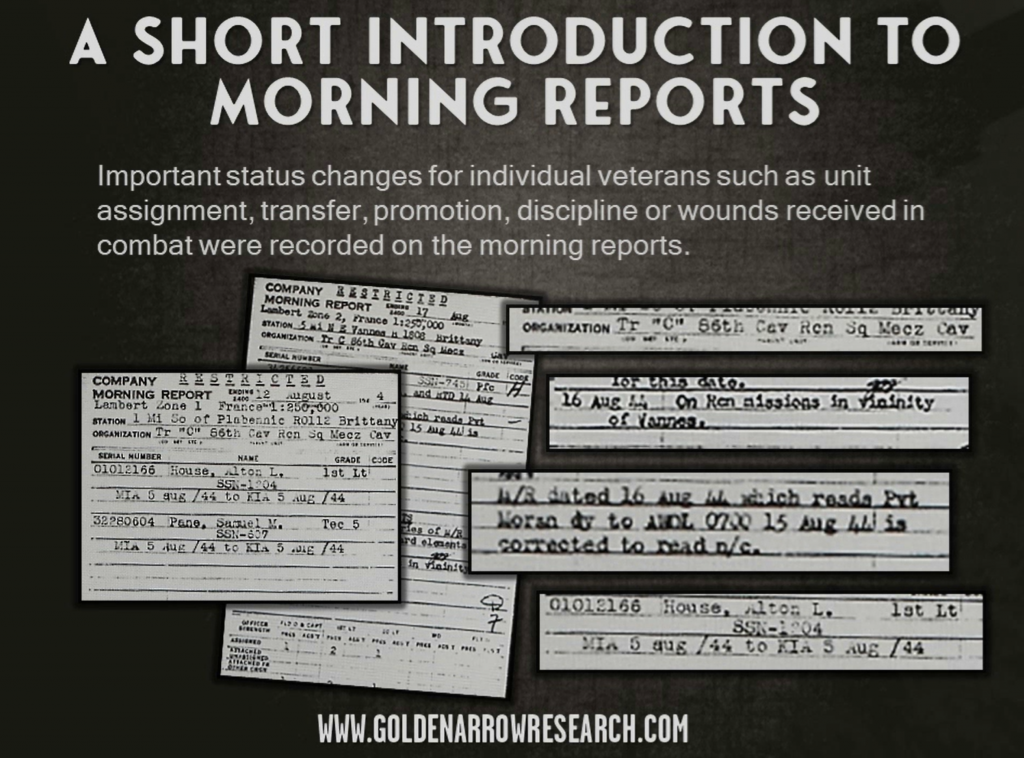
If you are researching an individual Army or Air Force veteran the morning reports allow you to trace their movements, showing where they were and what they were doing during their time in the service.

Whether researching General Eisenhower as he planned for the invasion of Europe or tracing the movements of the lowest ranking Private whose duty it was to wash Ike’s underpants – you can follow either veteran day by day using the morning reports of their respective units.

Initially, the morning reports were handwritten in cursive on pre-formatted cards. Unit clerks recorded the day’s events and submitted them to supervising officers for inspection before the records were transferred to Army record-keeping units for storage.

This continued until 1943 when the Army required that the reports be typed rather than written by hand.

Detail on the morning reports in WWII and the Korean War became more organized and consistent, with serial numbers included for all veterans.

When the U.S. Army entered the Korean War the morning reports were enlarged providing more space to record events and personnel status changes. These enlarged reports were used until the morning reports were phased out in 1974.

Prior to the catastrophic 1973 fire which destroyed most Army service records at the National Archives, morning reports were primarily used to verify eligibility for benefits or awards- which may have been omitted from the veteran’s Official Military Personnel File.

After the fire, the morning reports were used more broadly by both the Department of Veteran Affairs and the National Archives as they sought to verify benefits eligibility for veterans whose service records were consumed in the fire.

Today, the morning reports can be viewed in person at the National Archives where they are maintained on microfilm.

Tracing the Steps of Your Veteran
The earliest variation of morning reports used during WWI included a ‘general record of events’ section which often detailed movement and locations where the men in each company were stationed.

These notations often document overseas transport and unit Headquarters locations when there was a change in station.

Information about the individual soldiers who were assigned to the company was packed onto the standardized lines of the report which document each day of the month.
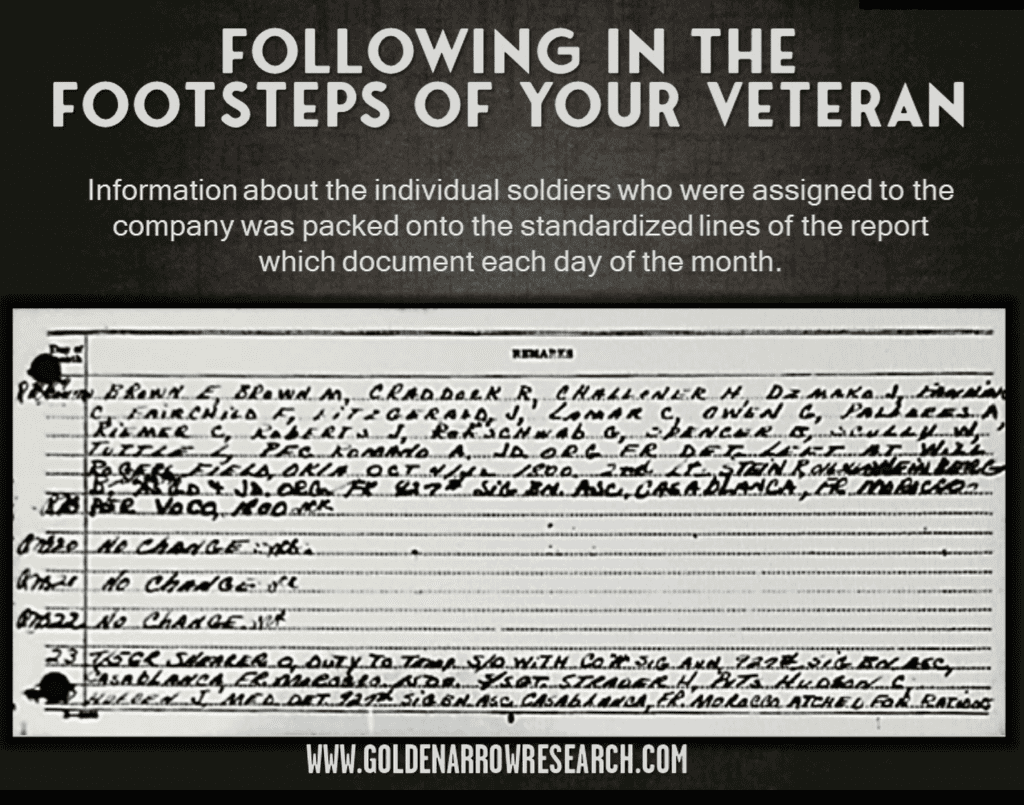
These names run across each page from left to right in an almost stream of consciousness-like flow. Directly after the string of names, you will find a notation referring to the men who were previously listed on the page.

During WWII the morning reports became more efficient, with each page heading indicating the unit designation, date, geographical location, and map coordinates. Many of the WWII map codes used in Europe can be translated to longitude and latitude for precise GPS mapping, allowing us to follow a veteran’s footsteps through the war.
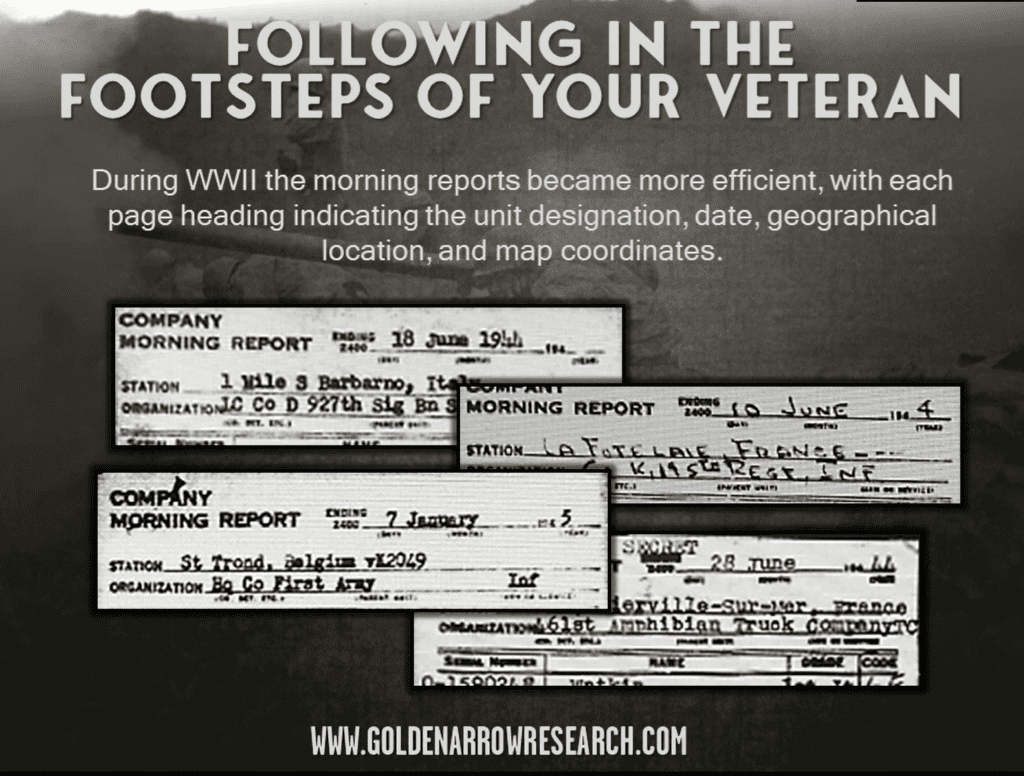
When veterans were fighting through the Jungles of the Pacific or the rugged terrain of Korea it is more common to see a general location or approximation for each day’s station. Because many morning reports were drafted in hazardous conditions and extreme climates it is also common to find degraded quality on some of the reports.
On WWII morning reports the notations pertaining to the individual men within the unit appear on the lines beneath the heading of each page. The morning reports are ‘omissions based’ meaning that only the names of men with status changes are mentioned.

So, for example, if you were promoted or wounded then your name would appear on the report for that date. If nothing happened to you then you would not be mentioned. The name of the soldier along with their rank and serial number appears first, with the status change listed on the lines beneath their name.

The morning reports utilize what is essentially a form of military shorthand as a way to fit all of the necessary data on the relatively small space provided. For example: the word assigned appears as ‘asgd’, sick usually appears as ‘sk’, wounded in action appears as ‘wia’, returned to duty appears as ‘rtd’. There are many, many abbreviations found in the morning reports and not all of them are official.

At the bottom of each morning report for WWII and the Korean War a ‘record of events’ section is also included.

Sometimes this section includes a detailed account of small-unit combat actions for each day which can allow for an incredibly detailed and personal understanding of your veteran’s wartime experiences.
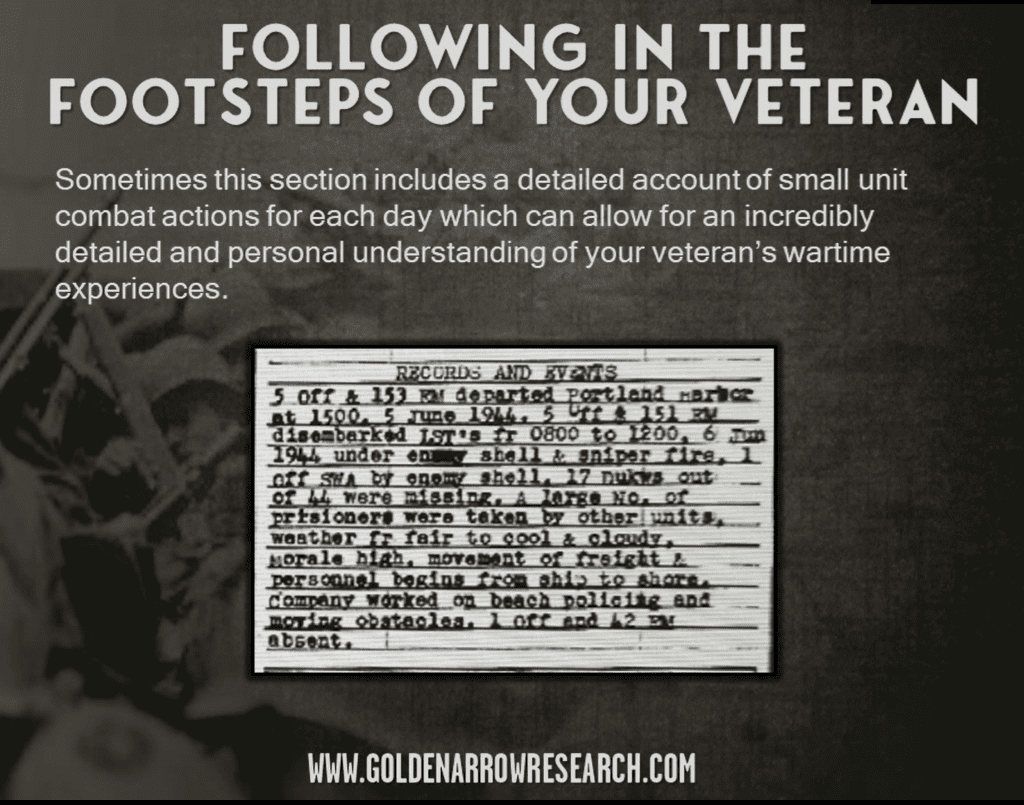
The very bottom of each page includes detail on unit strength, rations and then a signature of the commanding officer who signed off on each day’s report.
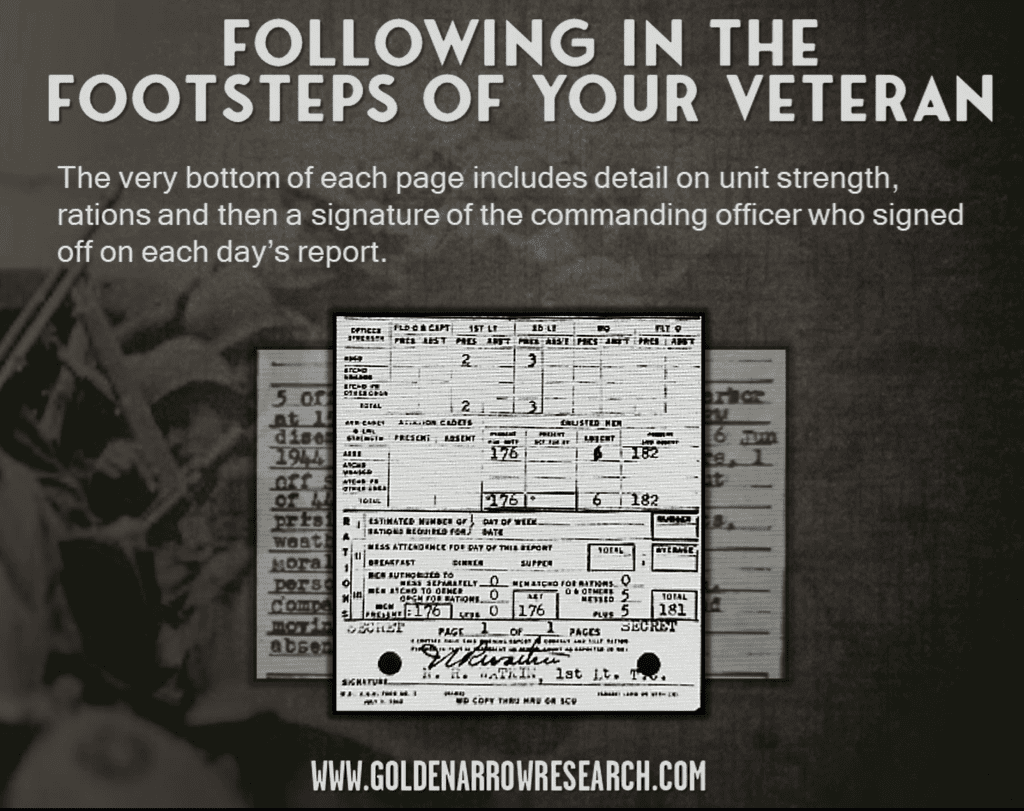
During the Vietnam War, the morning reports focused only on the personnel and headquarters location. The ‘record of events’ section describing action or movement taking place was removed from the forms. Depending on the unit and dates being researched it may be possible to use after-action reports or command reports to fill this gap.

Starting Your Research Journey
It is technically possible to document every step of a veteran’s service from start to finish using the morning reports. This type of detail is difficult to assemble because of the limitations of the reports themselves and the enormity of the armed forces during various conflicts.
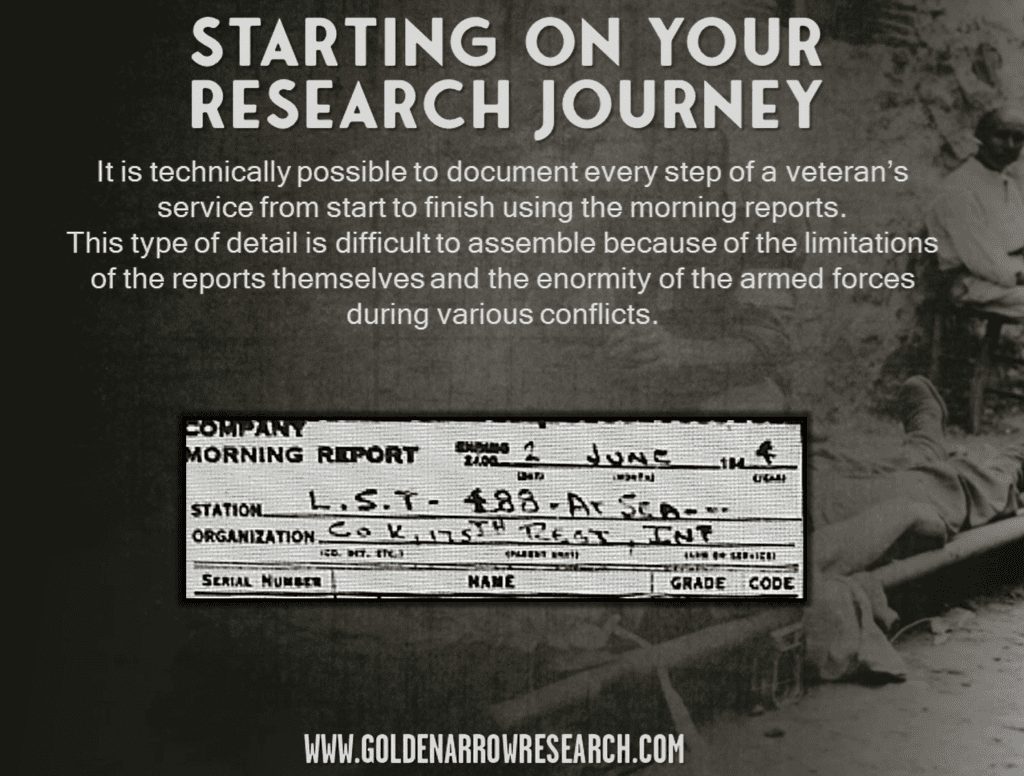
Stateside training periods are easier to document for veterans who stayed with the same unit throughout the war. In most cases, it is wise to skip US training periods and stick to using the morning reports to research the core overseas unit to which the veteran was assigned. This allows us to gain a clear understanding of their main contribution to the war effort.
Request Your Army Veteran’s Morning Reports
[contact-form-7 id=”1796″ title=”Army Morning Reports”]

